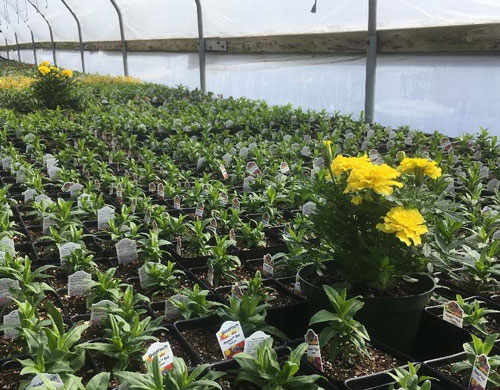7/1/2023
Turning the Tide on Thrips & Botrytis
Laura Barth

Thrips and Botrytis: These twin terrors can be a source of unending nightmares for growers, universally acknowledged as two of the most devastating and difficult-to-manage pests in the industry. Growers have waged a constant battle against them, facing significant challenges in their quest for efficient and sustainable management strategies.
Recognizing the need for solutions, the American Floral Endowment (AFE) heeded the call to action in 2017 and launched a landmark initiative: the “Thrips and Botrytis Campaign.” This campaign represents a united front of researchers and industry leaders looking for sustainable and practical solutions to manage thrips and Botrytis. The widespread commitment to this cause was evident in the swift mobilization of resources, with an impressive $1.5 million raised by 2019 through the generous contributions of 24 industry sponsors.
To date, we’ve proudly supported a total of 14 multi-year research projects with these funds, spanning a diverse range of topics and methodologies, with even more groundbreaking initiatives still in the pipeline, including seeking out new research to target the recent threats posed by Thrips parvispinus. We also presented two educational training sessions in 2022, with more potentially in the works.
 Pictured: The effect of natamycin, calcium and combinations of both on Botrytis blight severity of cut roses when applied as postharvest dips. Postharvest mixtures of calcium (1,000 ppm) and natamycin (500 ppm) result in disease severity reductions comparable to the best-performing commercial fungicide.
Pictured: The effect of natamycin, calcium and combinations of both on Botrytis blight severity of cut roses when applied as postharvest dips. Postharvest mixtures of calcium (1,000 ppm) and natamycin (500 ppm) result in disease severity reductions comparable to the best-performing commercial fungicide.
But our campaign goes beyond funding research—we believe in empowering the industry through sharing knowledge. As part of this commitment, we’ve invested in the creation of a rich portfolio of educational resources for growers. This month marks an exciting milestone in our journey as we unveil our extensive results and insights to the industry. This includes a comprehensive index of articles, videos and essential takeaways, many of which are offered in both English and Spanish, that are now readily accessible to growers for the first time via our website at endowment.org/tb. We’ll also be disseminating some of this information via our social media and newsletters in the coming months—subscribe and follow if you haven’t yet!
As part of this release, we invite you to join us at Cultivate on Monday, July 17, from 10:30 to 11:30 a.m. for a special presentation where we’ll be showcasing some of our practical takeaways from expert researchers Dr. Jim Faust of Clemson University and Dr. Rose Buitenhuis of Vineland Research & Innovation Centre.
Here’s a brief overview of some of the many topics and takeaways you’ll be able to find on our website:
Thrips management
As you know, thrips develop resistance to insecticides very rapidly. Historically, thrips control measures have been successful, to some extent, due to the introduction of new classes of insecticides and research showing the proper insecticide rotation and cultural practices. However, the industry is seeing fewer and fewer new insecticide classes introduced to the market, so thrips seem to be developing a greater resistance to existing insecticides.
One of the priorities of our thrips research was looking at how best to use insecticides in concert with biocontrols and IPM so that specific recommendations could be developed for the industry. Here are a few of our findings:
Scouting: Early detection through regular scouting continues to be crucial for effective thrips control. On our website, you’ll find a number of different resources for scouting, detection and identification of thrips before they become a problem in your operation.
UV light exposure: Exposure to UV light can impact the survival and behavior of both adult and larval thrips, albeit to varying degrees. While adults were more resilient, larvae exhibited higher mortality rates with increased UV light exposure. Maximum efficacy was achieved by exposing plants to light from the side. This allowed for a lethal dose of UV-C light to thrips populations on the undersides of leaves without significant plant damage. This project is still underway, so stay tuned for more results on how to use UV light in your operation.
 Marigolds as “guardian plants”: Yellow marigolds have shown to be an effective and economical solution to thrips control when implemented early in the season. As guardian plants, marigolds attract thrips away from the main crops. Once on the marigolds, thrips can be targeted by predatory mites and Beauveria bassiana, an insect-killing fungus mixed in the soil.
Marigolds as “guardian plants”: Yellow marigolds have shown to be an effective and economical solution to thrips control when implemented early in the season. As guardian plants, marigolds attract thrips away from the main crops. Once on the marigolds, thrips can be targeted by predatory mites and Beauveria bassiana, an insect-killing fungus mixed in the soil.
Pictured: Marigold guardian plants, when combined with predatory mites and/or fungi, can be an effective tool for thrips management early in the season.
Cutting dips: Dipping unrooted cuttings in specific products that work on contact with pests has shown to be effective in managing thrips. Our research demonstrated optimum results for thrips with 0.1% to 0.5% (v/v) mineral oil (e.g., landscape oil or SuffOil-X) or 2.5 g/L BotaniGard 22WP on various crops. Adjust the rate according to the sensitivity of the crop to oil-based products. Good sanitation, careful application and testing on small batches are key to ensuring success with this method.
Hyperspectral imaging: Hyperspectral imaging technology has demonstrated the ability to detect even minor thrips infestations in Chrysanthemum with roughly 75% accuracy.
Botrytis management
Botrytis management is extremely difficult since spores germinate at a wide range of temperatures, including temperatures typically used for shipping and storage. Spores will germinate in four to eight hours if water is present. In other words, the conditions used for production, shipping and storage are perfect for Botrytis growth. Additionally, the spores survive on living or decayed plant material for up to one year and may be spread by water, wind, or on the hands and clothes of workers. Our Botrytis research focused on:
 Scouting and pre-season prep: Scouting is extremely important for Botrytis control. Regular scouting can aid in early detection of Botrytis, enabling proactive management and treatment. On our website, you can find a pre-season checklist, ID guides (since other fungi may present similar symptoms and look similar) and other recommendations to reduce the risk of Botrytis early in the season before it becomes an issue later.
Scouting and pre-season prep: Scouting is extremely important for Botrytis control. Regular scouting can aid in early detection of Botrytis, enabling proactive management and treatment. On our website, you can find a pre-season checklist, ID guides (since other fungi may present similar symptoms and look similar) and other recommendations to reduce the risk of Botrytis early in the season before it becomes an issue later.
Pictured: UV-C light applied from the side can kill thrips on the underside of leaves without any significant plant damage. Photo courtesy of Dr. Bruce Parker, University of Vermont.
Postharvest management: Effective postharvest strategies are crucial to reducing Botrytis infection on cut flowers and exposure to ethylene can result in a significant increase in Botrytis damage. Postharvest dips for cuts in calcium chloride solutions and calcium chloride sprays for bedding plants can significantly reduce Botrytis blight. Pre-cooling the packed boxes before placement into coolers enhances the vase life, slows down bud opening, minimizes flower Botrytis damage and reduces the frequency of Botrytis on leaves.
Fungicide resistance: While fungicides can be effective, Botrytis can quickly develop resistance. To mitigate this, it’s crucial to rotate fungicides and use them sparingly, only when necessary. One of our studies showed that resistance to FRAC 1 and FRAC 2 was consistently observed over time, while little to no resistance was observed for some FRAC 7s (pydiflumetofen) or FRAC 19 (polyoxin-D). Reserve an effective FRAC code for post-harvest applications to ensure maximum fungicide efficacy.
Chitosan: Chitosan, a byproduct from the seafood industry that contains antifungal and disease-suppressing properties, was effective at reducing Botrytis severity on the leaves of petunia and showed potential as a new tool to include in an IPM program to keep Botrytis from spreading to the flowers.
Biocontrol: Biological control agents have shown promise in managing Botrytis, especially when used with other treatments such as Calcium sprays and postharvest dips (read more below). Our research compared the efficacy of existing biocontrol options, as well as investigated new beneficial bacteria that could potentially be utilized as biocontrol tools.
Calcium applications: Calcium applications through flower sprays (petunias) and postharvest dips (cut flowers) have been effective at reducing Botrytis blight. Postharvest mixtures of calcium (1,000 and 2,000 ppm) and natamycin (500 ppm) result in disease severity reductions comparable to the best-performing commercial fungicide (Miravis Prime: pydiflumetofen + fludioxonil). This combination is very promising for commercial use as a postharvest dip for cut flowers. GT
Do you have any further research you’d like to see AFE address? Tell us by completing a brief form at bit.ly/AFEResearch.
Laura Barth (lbarth@afeendowment.org) is the Research Coordinator at the American Floral Endowment.